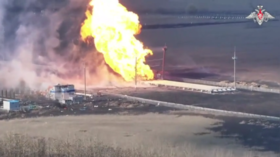US weapons makers celebrate ‘benefits’ from tensions with Russia

Rock bottom relations between Moscow and the West, along with the looming prospect of a conflict in Eastern Europe, bode well for firms cashing in on sending arms overseas, two of America’s largest weapons exporters have admitted.
As Washington spends increasingly large sums of cash on military equipment for Ukraine, Raytheon and Lockheed Martin told investors this week that escalation in the region bodes well for their bottom line, in transcripts released by investment site The Motley Fool.
On a January 25 earnings call, Raytheon CEO Greg Hayes said, “we just have to look to last week where we saw the drone attack in the UAE, which have attacked some of their other facilities. And of course, the tensions in Eastern Europe, the tensions in the South China Sea, all of those things are putting pressure on some of the defense spending over there. So I fully expect we’re going to see some benefit from it.”
The same day, Jim Taiclet, CEO of Lockheed Martin, also advised investors that the likelihood of further American involvement in Eastern Europe would be good for business. “If you look at the evolving threat level and the approach that some countries are taking, including North Korea, Iran and through some of its proxies in Yemen and elsewhere, and especially Russia today, and China, there’s renewed great power competition that does include national defense and threats to it,” he said.
Taiclet noted that “the history of the United States is, when those environments evolve, we do not sit by and just watch it happen. So I can’t talk to a number, but I do think, and I’m concerned personally that the threat is advancing, and we need to be able to meet it.”
In a January 26 earnings call, Brian West, CFO of aerospace and weapons contractor Boeing, did not reference Ukraine and Russia directly, but acknowledged that strong bipartisan support for military spending in Washington has ensured that the company sees “stable demand.”
According to Brown University’s Costs of War Project, the arms industry has spent $2.5 billion on government lobbying over the past two decades, employing, on average, more than 700 lobbyists per year. Pentagon spending has exceeded $14 trillion since the start of the war in Afghanistan, and one-third to a half of that money has gone to military contractors.
In the 1990s, arms manufacturers spent tens of millions of dollars lobbying for the expansion of NATO, the US-led military bloc, into Eastern Europe, after the industry shrank following the collapse of the USSR and the end of the Cold War.
The push for NATO expansion started, in the 90s, when Russia had a very US-friendly government, and wasn't threatening anyone. As with most things, it was about $$'s. US arms makers were looking for new customers & lobbied heavily. Here's how @nytimes reported it, at the time. pic.twitter.com/vj6AKjxhwz
— Bryan MacDonald (@27khv) January 10, 2022
Here's a 1998 @nytimes article explaining why NATO continued to expand after the Warsaw Pact collapsed. American arms manufacturers "made enormous investments in lobbyists" to open up "new & hugely lucrative" markets in Europe at a time when US-Russian relations were good. pic.twitter.com/7g5YElVPdX
— Bryan MacDonald (@27khv) February 19, 2021
Tensions around Ukraine have been high for months, with Western leaders claiming they fear Russia is planning an imminent invasion of its neighbor, and pointing to reports that more than 100,000 Russian soldiers have massed near the shared border. Moscow has denied that it has any aggressive intentions, and has called for security agreements that would prohibit NATO from expanding into Ukraine or Georgia, a deal that Washington has said is off the table.














